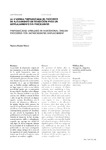Mostrar o rexistro simple do ítem
La vivienda prefabricada en procesos de alojamiento de transición para un desplazamiento sin precedentes
| dc.contributor.author | Muñiz Núñez, Patricia | |
| dc.date.accessioned | 2018-04-16T12:44:52Z | |
| dc.date.available | 2018-04-16T12:44:52Z | |
| dc.date.issued | 2017 | |
| dc.identifier.citation | Boletín Académico, 2017, 7: 115-134. ISSN 2173-6723 | |
| dc.identifier.issn | 2173-6723 | |
| dc.identifier.uri | http://hdl.handle.net/2183/20502 | |
| dc.description.abstract | [Resumen] La provisión de alojamiento después de una emergencia es una de las prioridades de la ayuda humanitaria, tanto en cuestión de catástrofes naturales como de desplazamiento por conflictos bélicos. No solo durante los primeros días sino, incluso más, durante el proceso de reconstrucción, momento en el que es determinante que las familias puedan establecerse en un lugar seguro y volver a una relativa normalidad, puesto que la consecución de una solución duradera podría dilatarse años. No obstante, también es una de las acciones más difíciles y costosas de llevar a cabo, lo que ha provocado en algunos expertos posturas disconformes con la dotación de alojamientos, diferentes a las tiendas, durante dicho proceso. En especial, de aquellos producidos en serie en una fábrica. Con el análisis de experiencias contemporáneas ponemos de manifiesto en este artículo la importancia de la prefabricación en la facilitación rápida de vivienda de transición, de fácil montaje, económicamente viable y culturalmente aceptada; que suponga una calidad de vida digna de forma temporal. Además de la necesidad de la implicación de los profesionales en una mayor investigación en dicho campo, siempre de la mano de los organismos de ayuda humanitaria, de manera que la teoría y la práctica juntas produzcan un resultado tangible.[Absract]The provision of shelter after an emergency is one of the priorities of humanitarian Aid, both in situations of natural catastrophes and in displacement due to armed conflict. Not only over the first few days, but also, and even more so, during the reconstruction process, a moment in which it is crucial that families can settle down in a safe place and return to a situation of relative normality, since establishing a longlasting solution may stretch out over the years. Nevertheless, it is also one of the most difficult and costly actions to carry out, a fact which has caused some experts to take a dissenting posture in relation to the allocation of shelters, other than tents, in this process; and more specifically those produce in series in a factory. With the analysis of contemporary experiences, in this article we hereby acknowledge the relevance of prefabrication in the quick provision of transitional shelters, of easy assembly, economically feasible and culturally accepted; which implies a dignified quality of life in a temporary way. Additional to the need of the implication of professionals in a deeper research in this area, hand in hand with humanitarian help organizations, for the theory and the practice together to produce a tangible result. | |
| dc.description.abstract | [Abstract] The provision of shelter after an emergency is one of the priorities of humanitarian Aid, both in situations of natural catastrophes and in displacement due to armed conflict. Not only over the first few days, but also, and even more so, during the reconstruction process, a moment in which it is crucial that families can settle down in a safe place and return to a situation of relative normality, since establishing a longlasting solution may stretch out over the years. Nevertheless, it is also one of the most difficult and costly actions to carry out, a fact which has caused some experts to take a dissenting posture in relation to the allocation of shelters, other than tents, in this process; and more specifically those produce in series in a factory. With the analysis of contemporary experiences, in this article we hereby acknowledge the relevance of prefabrication in the quick provision of transitional shelters, of easy assembly, economically feasible and culturally accepted; which implies a dignified quality of life in a temporary way. Additional to the need of the implication of professionals in a deeper research in this area, hand in hand with humanitarian help organizations, for the theory and the practice together to produce a tangible result. | |
| dc.language.iso | spa | |
| dc.publisher | Universidade da Coruña | |
| dc.relation.uri | https://doi.org/10.17979/bac.2017.7.0.1853 | |
| dc.rights | Atribución 3.0 España | |
| dc.rights.uri | http://creativecommons.org/licenses/by/3.0/es/ | |
| dc.subject | Emergencia | |
| dc.subject | Refugiados | |
| dc.subject | Transición | |
| dc.subject | Prefabricación | |
| dc.subject | Innovación | |
| dc.subject | Emergency | |
| dc.subject | Refugees | |
| dc.subject | Transitional | |
| dc.subject | Prefabrication | |
| dc.subject | Innovation | |
| dc.title | La vivienda prefabricada en procesos de alojamiento de transición para un desplazamiento sin precedentes | |
| dc.title.alternative | Prefabricated Dwelling in Transitional Shelter Processes for Unprecedented Displacement | |
| dc.type | info:eu-repo/semantics/article | |
| dc.rights.access | info:eu-repo/semantics/openAccess | |
| UDC.journalTitle | Bac Boletín Académico. Revista de investigación y arquitectura contemporánea | |
| UDC.volume | 7 | |
| UDC.issue | 1 | |
| UDC.startPage | 115 | |
| UDC.endPage | 134 |






